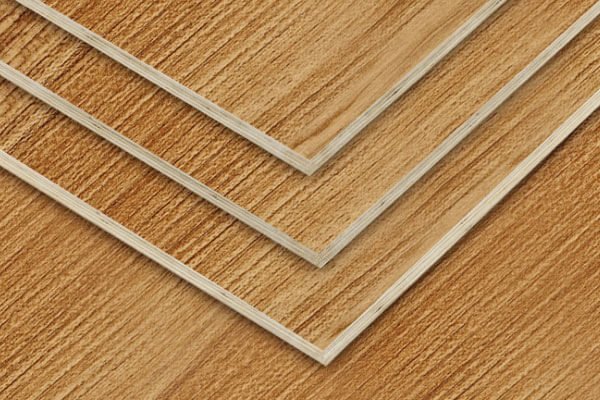Laminate vs. Melamine Finish on Wood Displays: Making the Right Choice

Table Of Content:
When it comes to choosing finishes for wood displays, furniture, and cabinetry, you’re likely to encounter the terms “laminate” and “melamine.” Both are popular choices for their affordability and versatility, but they have distinct characteristics and applications. In this comprehensive blog post, we’ll explore the key differences between laminate and melamine finishes to help you make an informed decision for your specific needs.
Composition and Construction
Laminate: Laminate is a composite material composed of multiple layers. At its core, you’ll often find either particleboard or medium-density fiberboard (MDF). The top layer is a printed paper that can replicate the appearance of wood, stone, or various other materials. This layer is then sealed with a clear, protective overlay.
Melamine: Melamine, on the other hand, is a thermosetting plastic material. It is applied as a thin coating over a substrate, which is typically particleboard or MDF. Melamine is known for its smooth and glossy surface, which differs from the layered construction of laminate.
Visual Appearance
Laminate: Laminate is widely acclaimed for its ability to closely mimic the look of natural materials. The top layer can feature an array of designs, colors, and textures, allowing you to achieve a specific aesthetic. From wood grain patterns to glossy marble finishes, laminate offers a diverse range of options to match your style.
Melamine: Melamine finishes often have a smooth, glossy appearance. While they come in various solid colors and patterns, they are generally not as realistic in replicating the look of natural materials when compared to laminate. Melamine’s strength lies more in its uniform and sleek appearance.
Durability
Laminate: One of the primary advantages of laminate is its durability. The clear protective overlay on the top layer of laminate makes it more resistant to scratches, abrasions, and impacts. This quality makes it an excellent choice for high-traffic areas where wear and tear are concerns.
Melamine: Melamine is also durable, but it tends to be less robust than laminate. It is more prone to chipping, scratching, and damage from heat. Consequently, it may not hold up as well in environments with heavy use or frequent impact.
Cost
Laminate: Due to its more complex manufacturing process and its ability to convincingly mimic natural materials, laminate is often slightly more expensive than melamine. While it provides excellent value for its cost, it may not be the most budget-friendly option.
Melamine: Melamine is a more economical choice. Its cost-effectiveness makes it a popular option for budget-conscious projects. However, it’s essential to consider its limitations and application suitability when opting for the cost-saving benefits of melamine.
Maintenance
Laminate: Laminate is relatively easy to clean and maintain. It can withstand moisture to some extent, but prolonged exposure to water can cause it to warp or swell. Regular cleaning and care can extend its lifespan.
Melamine: Melamine is also easy to clean, but it’s more susceptible to water damage. Excessive moisture exposure can lead to the swelling or separation of the edges. As such, it’s crucial to be cautious when using melamine in areas where water contact is likely.
Applications
Now that we’ve examined the differences between laminate and melamine, let’s consider the applications where each material shines.
Laminate:
- Kitchen Countertops: Laminate is a popular choice for kitchen countertops because of its wide range of designs, ease of cleaning, and resistance to stains.
- Cabinetry: Many homeowners and designers opt for laminate cabinet doors and panels for their durability and visual versatility.
- Commercial Spaces: Due to its durability and aesthetic appeal, laminate is often used in commercial spaces, including restaurants, offices, and retail stores.
Melamine:
- Budget-Friendly Furniture: Melamine is a common choice for affordable furniture, such as bookshelves, dressers, and wardrobes.
- Closet Interiors: The smooth, easy-to-clean surface of melamine makes it suitable for closet interiors, where its resistance to heavy impact is less of a concern.
- Low-Traffic Areas: Melamine can be an excellent option for displays and surfaces in areas with minimal wear and tear.
Making the Right Choice
When choosing between laminate and melamine finishes for your wood displays or furniture, consider the following factors to make the right decision:
- Aesthetic Preferences: Determine the look you want to achieve. If you’re aiming for a natural, textured appearance, laminate may be the better choice. For a smooth, glossy look, melamine is suitable.
- Durability Requirements: Consider the level of wear and tear the surface will endure. In high-traffic areas or spaces where resistance to scratches and impacts is crucial, laminate is the more durable option.
- Budget Constraints: Your budget plays a significant role. Laminate tends to be more expensive, while melamine is budget-friendly. Assess your project’s financial constraints and allocate resources accordingly.
- Maintenance Considerations: Think about the ease of maintenance and the likelihood of water exposure in the intended application. Laminate is more moisture-resistant than melamine.
- Application Specifics: Tailor your choice to the specific use of the material. Laminate is ideal for kitchen countertops, cabinetry, and commercial spaces, while melamine works well for budget-friendly furniture and low-traffic areas.
In summary, both laminate and melamine finishes offer unique advantages and are suitable for various applications. Your choice should align with your project’s requirements, design goals, and budget considerations. By carefully assessing these factors, you can ensure that your wood displays and furniture meet your expectations for both aesthetics and functionality.
Aldrich designs and manufactures custom point of purchase and retail product displays of all types. Our designers work with you to create the most effective and eye catching display for your product. Your inquiry will be answered within 12 hours.


